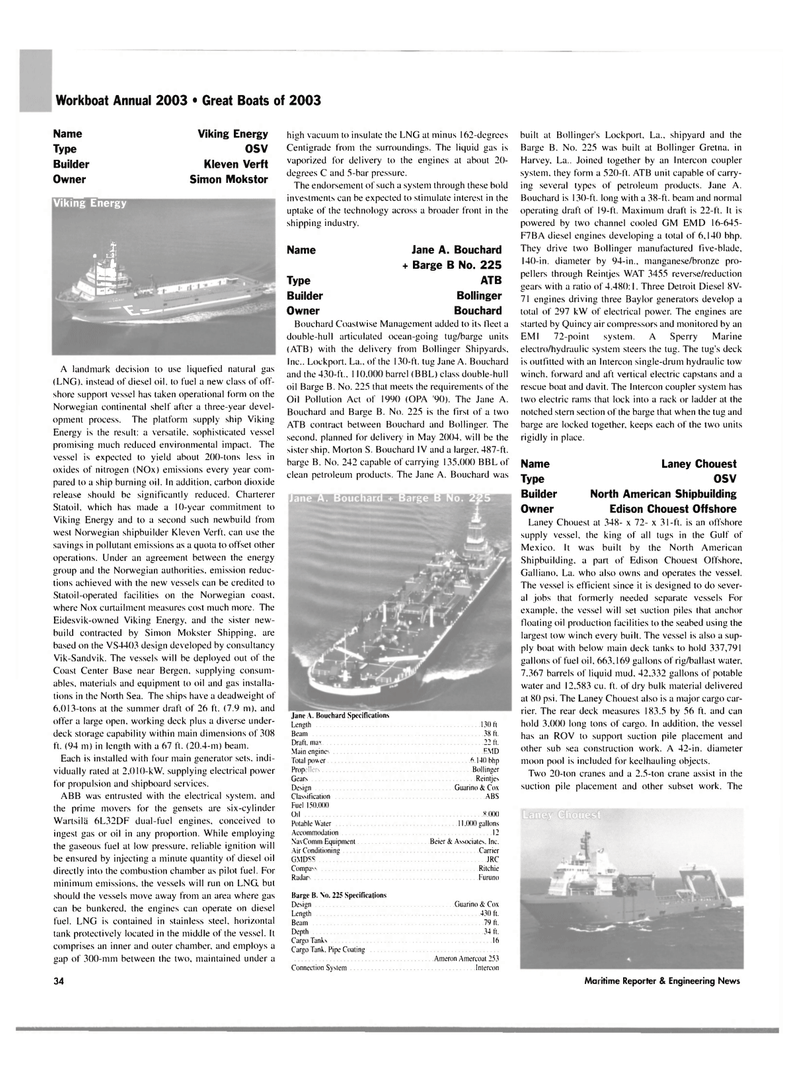
Page 34: of Maritime Reporter Magazine (November 2003)
Read this page in Pdf, Flash or Html5 edition of November 2003 Maritime Reporter Magazine
Workboat Annual 2003 • Great Boats of 2003
Name
Type
Builder
Owner
Viking Energy
OSV
Kleven Verft
Simon Mokstor
Viking Energy . |
A landmark decision to use liquefied natural gas (LNG). instead of diesel oil, to fuel a new class of off- shore support vessel has taken operational form on the
Norwegian continental shelf after a three-year devel- opment process. The platform supply ship Viking
Energy is the result: a versatile, sophisticated vessel promising much reduced environmental impact. The vessel is expected to yield about 200-tons less in oxides of nitrogen (NOx) emissions every year com- pared to a ship burning oil. In addition, carbon dioxide release should be significantly reduced. Charterer
Statoil, which has made a 10-year commitment to
Viking Energy and to a second such newbuild from west Norwegian shipbuilder Kleven Verft. can use the savings in pollutant emissions as a quota to offset other operations. Under an agreement between the energy group and the Norwegian authorities, emission reduc- tions achieved with the new vessels can be credited to
Statoil-operated facilities on the Norwegian coast, where Nox curtailment measures cost much more. The
Eidesvik-owned Viking Energy, and the sister new- build contracted by Simon Mokster Shipping, are based on the VS4403 design developed by consultancy
Vik-Sandvik. The vessels will be deployed out of the
Coast Center Base near Bergen, supplying consum- ables, materials and equipment to oil and gas installa- tions in the North Sea. The ships have a deadweight of 6,013-tons at the summer draft of 26 ft. (7.9 m), and offer a large open, working deck plus a diverse under- deck storage capability within main dimensions of 308 ft. (94 m) in length with a 67 ft. (20.4-m) beam.
Each is installed with four main generator sets, indi- vidually rated at 2,()l()-kW. supplying electrical power for propulsion and shipboard services.
ABB was entrusted with the electrical system, and the prime movers for the gensets are six-cylinder
Wartsilii 6L32DF dual-fuel engines, conceived to ingest gas or oil in any proportion. While employing the gaseous fuel at low pressure, reliable ignition will be ensured by injecting a minute quantity of diesel oil directly into the combustion chamber as pilot fuel. For minimum emissions, the vessels will run on LNG. but should the vessels move away from an area where gas can be bunkered, the engines can operate on diesel fuel. LNG is contained in stainless steel, horizontal tank protectively located in the middle of the vessel. It comprises an inner and outer chamber, and employs a gap of 300-mm between the two, maintained under a 34 high vacuum to insulate the LNG at minus 162-degrees
Centigrade from the surroundings. The liquid gas is vaporized for delivery to the engines at about 20- degrees C and 5-bar pressure.
The endorsement of such a system through these bold investments can be expected to stimulate interest in the uptake of the technology across a broader front in the shipping industry.
Jane A. Bouchard + Barge B No. 225
ATB
Bollinger
Bouchard
Name
Type
Builder
Owner
Bouchard Coastwise Management added to its fleet a double-hull articulated ocean-going tug/barge units (ATB) with the delivery from Bollinger Shipyards.
Inc.. Lockport. La., of the 130-ft. tug Jane A. Bouchard and the 430-ft.. 110,000 barrel (BBL) class double-hull oil Barge B. No. 225 that meets the requirements of the
Oil Pollution Act of 1990 (OPA '90). The Jane A.
Bouchard and Barge B. No. 225 is the first of a two
ATB contract between Bouchard and Bollinger. The second, planned for delivery in May 2004. will be the sister ship. Morton S. Bouchard IV and a larger. 487-ft. barge B. No. 242 capable of carrying 135,000 BBL of clean petroleum products. The Jane A. Bouchard was
Jane A. Bouchard Specifications
Length 130 ft
Beam 38 ft.
Draft, max 22 ft.
Main engines EMD
Total power 6.140 bhp
Propellers Bollinger
Gears Reintjes
Design Guarino & Cox
Classification ABS
Fuel 150,000
Oil 8,(KX)
Potable Water 11,000 gallons
Accommodation 12
NavComm Equipment Beier & Associates. Inc.
Air Conditioning Carrier
GMDSS ' JRC
Compass Ritchie
Radars Furuno
Barge B. No. 225 Specifications
Design Guarino & Cox
Length 430 ft.
Beam 79 ft.
Depth 34 ft.
Cargo Tanks 16
Cargo Tank. Pipe Coating
Ameron Amercoat 253
Connection System Intercon built at Bollinger's Lockport, La., shipyard and the
Barge B. No. 225 was built at Bollinger Gretna, in
Harvey, La.. Joined together by an Intercon coupler system, they form a 520-ft. ATB unit capable of carry- ing several types of petroleum products. Jane A.
Bouchard is 130-ft. long with a 38-ft. beam and normal operating draft of 19-ft. Maximum draft is 22-ft. It is powered by two channel cooled GM EMD 16-645-
F7BA diesel engines developing a total of 6,140 bhp.
They drive two Bollinger manufactured five-blade, 140-in. diameter by 94-in., manganese/bronze pro- pellers through Reintjes WAT 3455 reverse/reduction gears with a ratio of 4.480:1. Three Detroit Diesel 8V- 71 engines driving three Baylor generators develop a total of 297 kW of electrical power. The engines are started by Quincy air compressors and monitored by an
EMI 72-point system. A Sperry Marine electro/hydraulic system steers the tug. The tug's deck is outfitted with an Intercon single-drum hydraulic tow winch, forward and aft vertical electric capstans and a rescue boat and davit. The Intercon coupler system has two electric rams that lock into a rack or ladder at the notched stern section of the barge that when the tug and barge are locked together, keeps each of the two units rigidly in place.
Name Laney Chouest
Type OSV
Builder North American Shipbuilding
Owner Edison Chouest Offshore
Laney Chouest at 348- x 72- x 31-ft. is an offshore supply vessel, the king of all tugs in the Gulf of
Mexico. It was built by the North American
Shipbuilding, a part of Edison Chouest Offshore,
Galliano. La. who also owns and operates the vessel.
The vessel is efficient since it is designed to do sever- al jobs that formerly needed separate vessels For example, the vessel will set suction piles that anchor floating oil production facilities to the seabed using the largest tow winch every built. The vessel is also a sup- ply boat with below main deck tanks to hold 337,791 gallons of fuel oil, 663,169 gallons of rig/ballast water, 7,367 barrels of liquid mud, 42,332 gallons of potable water and 12,583 cu. ft. of dry bulk material delivered at 80 psi. The Laney Chouest also is a major cargo car- rier. The rear deck measures 183.5 by 56 ft. and can hold 3.000 long tons of cargo. In addition, the vessel has an ROV to support suction pile placement and other sub sea construction work. A 42-in. diameter moon pool is included for keelhauling objects.
Two 20-ton cranes and a 2.5-ton crane assist in the suction pile placement and other subset work. The
Maritime Reporter & Engineering News

 33
33

 35
35
